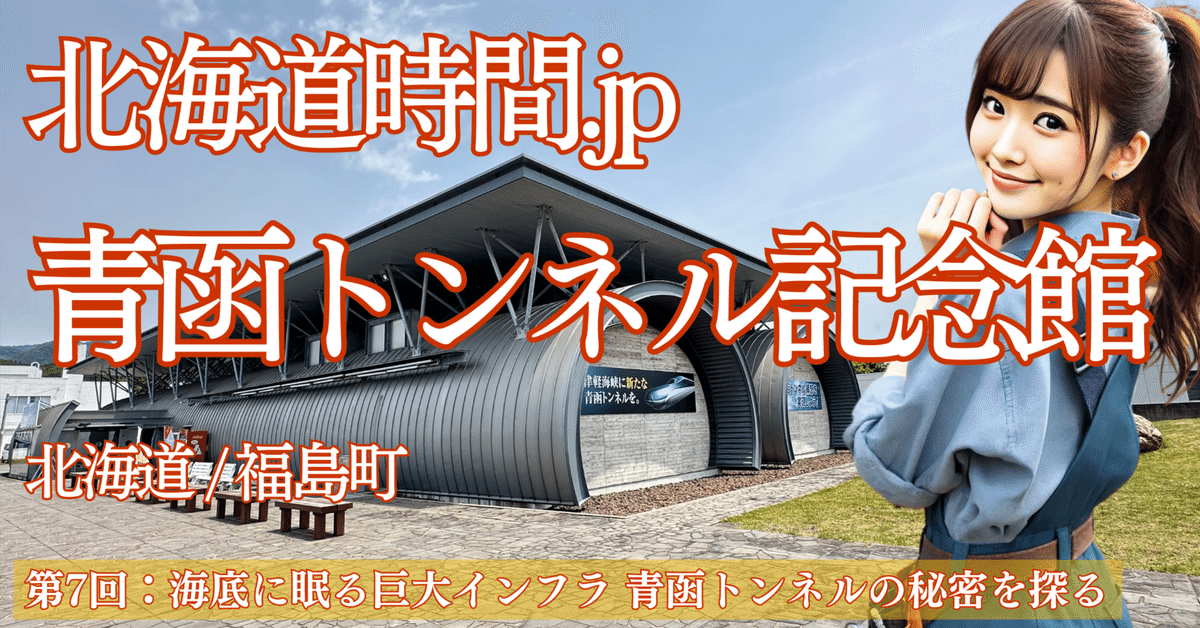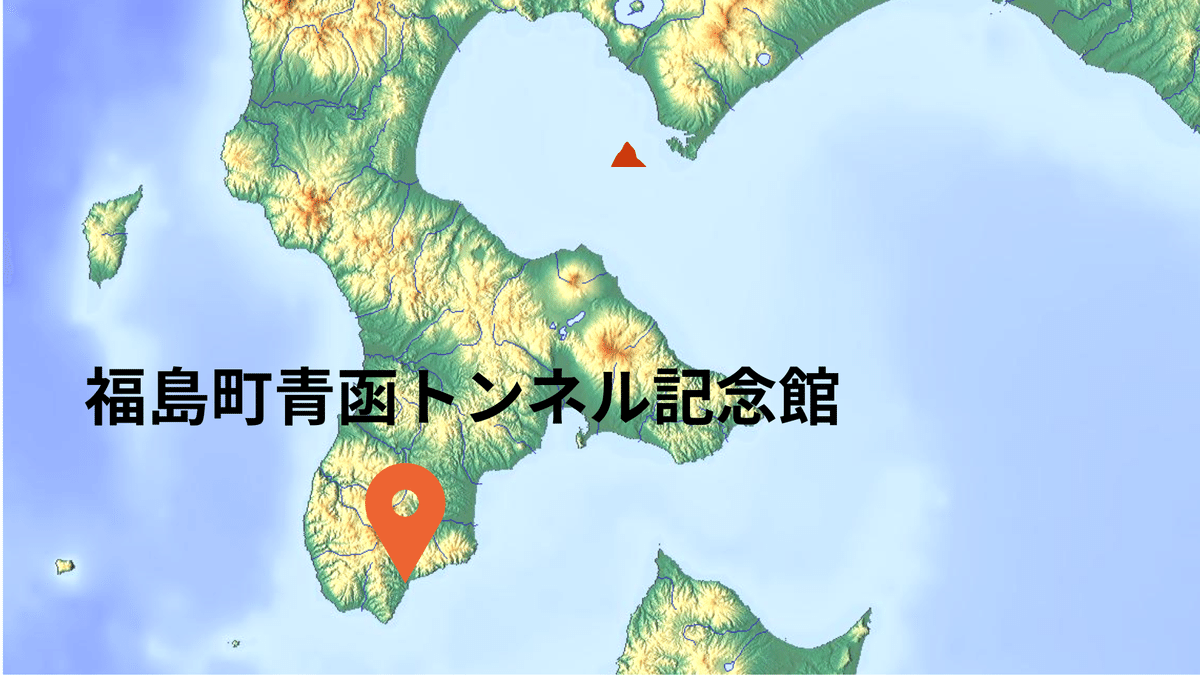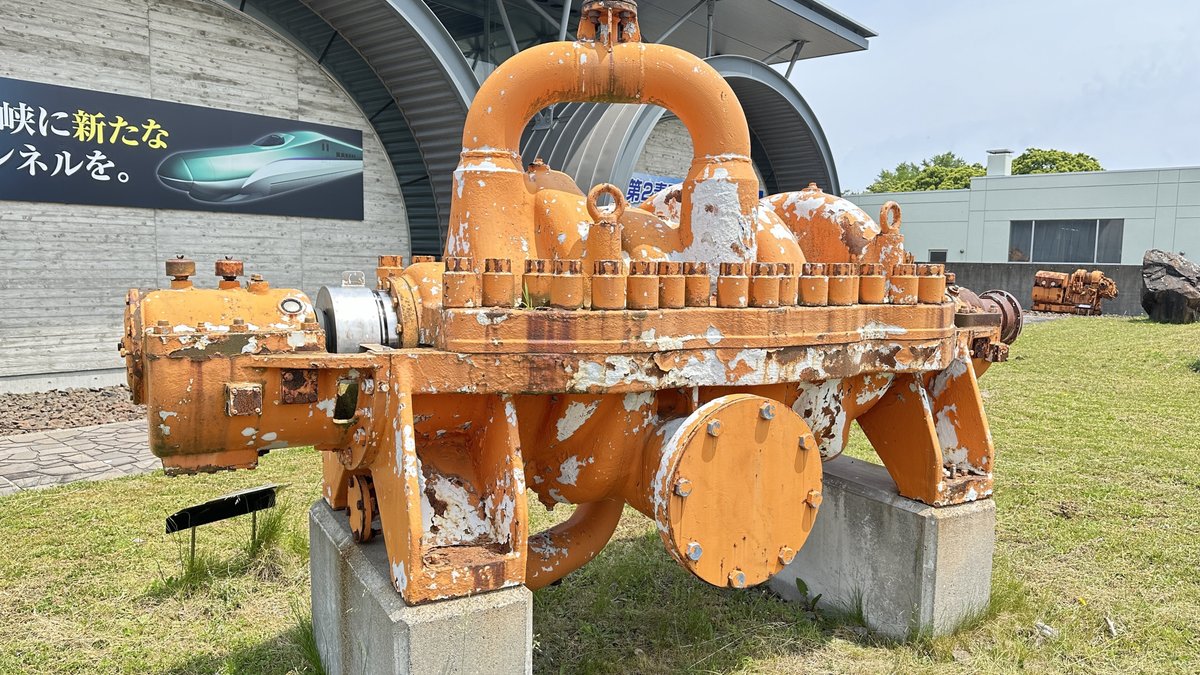
【北海道時間.jp】第7回:海底に眠る巨大インフラ 青函トンネルの秘密を探る
福島町青函トンネル記念館への訪問は、歴史と技術の融合を体感できる貴重な機会でした。この記念館は、世界最長の海底トンネルである青函トンネルの建設記録と土木技術を展示する施設です。外観は海底トンネルを連想させる円筒形の建物が特徴的で、まるで海中から姿を現したかのようなユニークなデザインが訪れる人々に強い印象を与えます。建物の入り口付近には、トンネル建設に使用された実際の重機が展示されており、その圧倒的な存在感から建設の難易度の高さが伺えます。

青函トンネルは、本州の青森県と北海道を結ぶ全長53.85kmの鉄道トンネルです。その構想は1923年に函館市議会議員の阿部覚治が「大函館論」の中で提案し、当時の青函連絡船の事故や悪天候による運行の遅延から、安全で安定した輸送手段の必要性が高まっていきました。1954年の青函連絡船洞爺丸事故をきっかけに、本格的な検討が始まり、1961年に日本鉄道建設公団が着工、1971年に本格的な工事が開始されました。

トンネルの建設は非常に困難なプロジェクトで、過酷な海底環境での掘削作業には高度な技術と設備が必要とされました。当時の最先端技術であるトンネルボーリングマシン(TBM)やシールド工法、ドリルアンドブラスト工法などが投入され、1983年に先進導坑が貫通、1985年に本坑が全貫通するまで、実に17年以上の歳月を要しました。トンネルは津軽海峡の海底約100mを通過し、その総延長は55kmにも及ぶ世界最長の海底トンネルとなりました。

トンネル内部は、単なる交通路にとどまらず、高度な設備を備えた最先端のインフラとなっています。通信ケーブルや送電線が敷設されており、北海道と本州を結ぶ重要な通信・エネルギー供給網の役割を果たしています。また、三線軌条を採用していることから、在来線特急列車と新幹線の両方が同一のトンネル内を走行できるように設計されています。このように多目的に機能するトンネルは、建設時から先駆的な発想が取り入れられていたことがうかがえます。

開業当初は快速「海峡」が主たる輸送手段でしたが、2002年の東北新幹線八戸開業に伴い、列車体系が大幅に変更され、特急・急行列車の運行に切り替わりました。さらに2016年の北海道新幹線開業以降は、新幹線のみがトンネルを走行する定期旅客列車となり、スピーディーな大量輸送が実現しています。一方で、このような高度な設備とサービスを維持するには、年間約8億円の多額の費用がかかります。この維持管理費の一部は国の補助金で賄われていますが、運営するJR北海道には大きな経済的負担となっています。このため1999年度から大規模な改修事業が進められており、その費用の3分の2を国が負担しています。

未来に向けては、2014年に貨物専用の新たなトンネル、第2青函トンネルの建設計画が発表されました。この計画は、既存の青函トンネルの混雑を緩和し、さらに貨物の大量輸送力を増強することで、日本全体の物流効率化を目指すものです。構想では工費約3900億円、工期15年を想定しています。さらに2017年には、より大がかりな計画も提示されました。貨物列車用と自動車用の2本のトンネルを新たに建設し、既存の青函トンネルを新幹線専用に特化するという構想です。この計画の事業費は約7500億円、工期は20年とされています。第2青函トンネルが完成すれば、日本の主要4島(本州、北海道、九州、四国)を自動車で行き来できるようになり、これまで海路輸送に頼らざるを得なかった自動車の移動が陸路で可能になります。物流面だけでなく、観光などの面でも大きな飛躍が期待されます。

青函トンネルは、単なる交通インフラにとどまらず、日本を代表する偉大な土木技術の象徴であり、多くの技術者と労働者の英知と努力の結晶です。その建設過程で培われた高度な施工技術や経験は、世界中の海底トンネルなどの大規模土木プロジェクトにおいても貴重な参考となり、技術革新を牽引するモデルケースとなっています。このような最先端の技術を結集してはじめて実現した青函トンネルは、日本の誇るべき技術力の頂点を象徴する存在と言えるでしょう。

記念館の展示では、実際にトンネル建設で使用された重機や技術資料が広く紹介されており、特に作業船「くろしおII号」の存在感は圧倒的です。この特殊潜水艦は当時の最先端技術を体現するものであり、過酷な海中環境で作業を行う建設関係者の勇気と執念を垣間見ることができます。さらに、トンネルの発案から完成に至る歴史を振り返る資料や模型などを前にすると、日本の土木技術が年月を経てどのように進歩を遂げてきたかを実感することができます。このように建設に関わった人々の並々ならぬ努力と情熱に直接触れられる貴重な展示は、訪れる者に強い感銘を与えることでしょう。また、シアターでは臨場感あふれる映像が上映され、過酷な自然環境に立ち向かいながらトンネル建設を成し遂げた技術者たちの偉業を目の当たりにでき、誰もが深い感動を覚えることになるはずです。

このように、福島町青函トンネル記念館は、青函トンネルの歴史と技術を存分に学ぶことのできる絶好の施設であり、日本の土木技術の偉大さを改めて実感する機会を提供してくれます。今なお北海道と本州を結ぶ重要な交通インフラとして機能する青函トンネルは、その壮大なスケールと先進的な技術力により、訪れる人々に感動と誇りをもたらし続けています。未来に向けて新たなトンネル計画が実現されれば、さらにその価値を高め、海峡を越える日本の物流と交流の発展に大きく貢献することでしょう。青函トンネルが、今後も日本の土木技術の粋を集めた誇れる存在として語り継がれていくことは間違いありません。

Visiting the Seikan Tunnel Museum in Fukushima Town was a valuable opportunity to experience the fusion of history and technology. This museum showcases the construction records and civil engineering techniques of the Seikan Tunnel, the world's longest undersea tunnel. Its exterior is characterized by a cylindrical building reminiscent of an underwater tunnel, giving visitors a strong impression with its unique design as if it had emerged from the sea. Near the entrance, there are actual heavy machines used in the tunnel's construction on display, whose overwhelming presence hints at the high difficulty of the construction.

The Seikan Tunnel is a 53.85 km long railway tunnel connecting Aomori Prefecture in Honshu and Hokkaido. The concept was proposed in 1923 by Kakushi Abe, a member of the Hakodate City Council, in his “Greater Hakodate Theory.” The need for a safe and stable means of transportation increased due to accidents and operational delays of the Seikan ferry caused by bad weather. Serious considerations began after the 1954 Seikan Ferry Tyoya Maru incident, and the Japan Railway Construction Corporation started the project in 1961, with full-scale construction beginning in 1971.

The tunnel's construction was a very challenging project, requiring advanced technology and equipment for excavation in harsh undersea conditions. Tunnel Boring Machines (TBMs), shield methods, and the drill and blast method, which were cutting-edge technologies at the time, were employed. It took over 17 years until the main tunnel breakthrough in 1985, with the pilot tunnel breakthrough in 1983. The tunnel passes approximately 100 meters below the seabed of the Tsugaru Strait, making it the world's longest undersea tunnel at a total length of 55 km.

Inside the tunnel, it functions not just as a transportation route but also as an advanced infrastructure with high-tech equipment. Communication cables and power lines are laid within, serving as a crucial communication and energy supply network connecting Hokkaido and Honshu. Additionally, it is designed with a three-rail track system, allowing both conventional express trains and Shinkansen to run within the same tunnel. This demonstrates the innovative thinking incorporated from the time of its construction.

Initially, the primary transportation method was the rapid train “Kaikyo,” but with the opening of the Tohoku Shinkansen to Hachinohe in 2002, the train system was significantly altered to operate express and limited express trains. Since the opening of the Hokkaido Shinkansen in 2016, only Shinkansen runs as regular passenger trains through the tunnel, achieving speedy and mass transportation. However, maintaining such high-level facilities and services costs approximately 800 million yen annually. Part of the maintenance cost is covered by government subsidies, but it poses a significant financial burden on JR Hokkaido. Therefore, a large-scale renovation project has been underway since 1999, with the government bearing two-thirds of the costs.
Looking to the future, a plan to construct a new cargo-only tunnel, the Second Seikan Tunnel, was announced in 2014. This plan aims to alleviate congestion in the existing Seikan Tunnel and further enhance the freight transport capacity, improving Japan's overall logistics efficiency. The plan envisions a construction cost of approximately 390 billion yen and a construction period of 15 years. Additionally, in 2017, a more extensive plan was presented to construct two new tunnels for freight trains and automobiles, dedicating the existing Seikan Tunnel exclusively for Shinkansen. The estimated project cost is about 750 billion yen, with a construction period of 20 years. Once the Second Seikan Tunnel is completed, it will enable automobile travel between Japan's four major islands (Honshu, Hokkaido, Kyushu, and Shikoku), making land travel possible for vehicles that previously had to rely on sea transportation. This will lead to significant advances not only in logistics but also in tourism.
The Seikan Tunnel is more than just a transportation infrastructure; it is a symbol of Japan's remarkable civil engineering and the result of the wisdom and efforts of many engineers and workers. The advanced construction techniques and experiences gained during its construction serve as invaluable references for large-scale civil engineering projects, such as undersea tunnels worldwide, driving technological innovation. The Seikan Tunnel, realized by integrating such cutting-edge technologies, stands as a pinnacle of Japan's technological prowess.
The museum displays a wide range of heavy machinery and technical materials used in the tunnel construction, with the presence of the working vessel “Kuroshio II” being particularly impressive. This special submarine embodies the cutting-edge technology of the time and offers a glimpse into the courage and tenacity of the construction personnel working in the harsh underwater environment. Additionally, the exhibits, including historical documents and models tracing the tunnel's conception to completion, allow visitors to appreciate the progress of Japanese civil engineering over the years. The dedication and passion of those involved in the construction are palpable, leaving a strong impression on visitors. Moreover, the theater presents immersive videos showcasing the engineers' achievements in overcoming harsh natural conditions, evoking deep emotions from all who watch.
In this way, the Seikan Tunnel Museum in Fukushima Town provides an excellent facility to thoroughly learn about the history and technology of the Seikan Tunnel, offering an opportunity to realize the greatness of Japanese civil engineering. The Seikan Tunnel, which still serves as an essential transportation infrastructure connecting Hokkaido and Honshu, continues to inspire and instill pride with its grand scale and advanced technology. Should the new tunnel plans come to fruition, they will further enhance its value, significantly contributing to the development of logistics and exchange across the strait. There is no doubt that the Seikan Tunnel will continue to be celebrated as a pinnacle of Japanese civil engineering.
